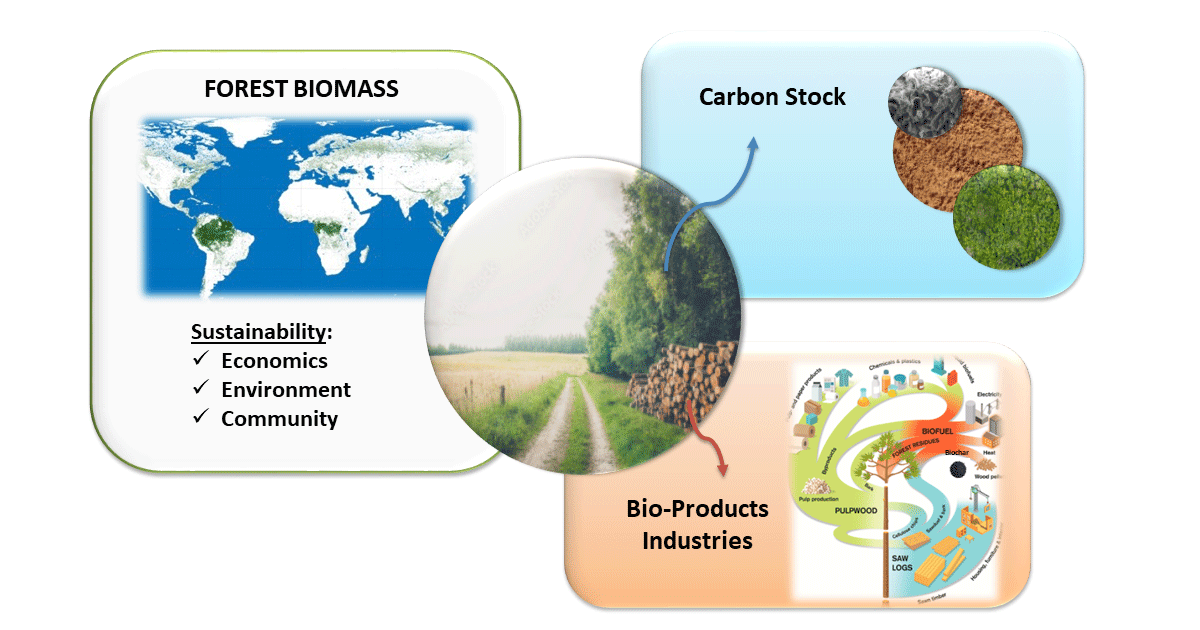Reaching Critical Biomass: Sustainability Potential for Forest Biomass Production & Products
A special issue of Sustainability (ISSN 2071-1050). This special issue belongs to the section "Sustainable Forestry".
Deadline for manuscript submissions: closed (1 March 2023) | Viewed by 13342

Special Issue Editors
Interests: dendroenergy; biochar; wood vinegar; bio-oil; pyrolysis; carbon sequestration; sustainability
Interests: agro-forestry economics; agricultural systems modeling; carbon sequestration; greenhouse gas emissions; sustainability
Special Issues, Collections and Topics in MDPI journals
Special Issue Information
Dear Colleagues,
Forest biomass is critical to the long-term sustainability, preservation, and biodiversity of terrestrial forest eco-systems and is used to produce bioenergy, bio-products, and agricultural products. Forest biomass also contributes to the medium-term sequestration of anthropogenic carbon dioxide. It can be used for building materials as well as pulp and paper products. Forest biomass is a renewable source of energy (e.g., heating and electricity generation) via managed woodlots or commercial forestry. Forest biomass can also be converted into cellulosic ethanol for fuel as well as agricultural soil amendments such as biochar and other bio products. Bio-products from forest biomass include wood vinegar and bio-oil, both with potential uses in chemical, pharma-chemical, and agriculture industries.
While forest biomass if often associated with preserved, conserved, and commercial forests, forest biomass research can also be essential to better understanding its relationship to agricultural production. For example, tapping North American temperate forest species such as sugar maple (Acer saccharum) for maple syrup production may negatively impact tree growth and biomass. Biomass of South American tropical forest species such as Brazil nut (e.g., Bertholletia excelsa) can be tempered by climatic shocks. Agro-forestry involves integration of commercial tree species within crop and/or livestock systems to enhance productivity of separate system components. Optimizing current and future forest biomass through improved management and re-forestation can increase terrestrial carbon stocks to help mitigate climate change. Multidisciplinary approaches are clearly needed to facilitate more integrated views on forest biomass given its complexity.
This Special Issue aims at gathering contributions exploring approaches to quantify woody biomass in forests and wood for construction, paper products, energy, soil amendment purposes (e.g., biochar), as well as other bio-products. We highly encourage applications tackling other related issues of forest-based wood and agricultural products, bioenergy, bio-product production, forest biomass, and carbon stocks in forest ecosystems and agro-forestry. Contributions dealing with integrated agricultural systems using forest species (e.g., Eucalyptus spp.) are welcome. While these topics focus on energy, resources, and enhancing food production for humans, which can be more economic in nature, we also welcome manuscripts measuring environmental and community impacts of forest biomass use by humans. This can range from adverse environmental and ecological impacts of human extraction and use of woody biomass to negative effects such industries have on nearby local communities. Submissions can also address positive impacts of increasing availability of forest biomass such as current and future needs for carbon sequestration, improved product life cycle analysis, as well as diversifying and stabilizing marginalized communities.
In this Special Issue, original research articles and reviews are welcome. Research areas on sustainability may include (but are not limited to) the following:
- Carbon sequestration using forest biomass
- Community and/or environmental impacts of forest biomass management, production, and utilization
- Crop, livestock, forestry integration (CLFI)
- Forest biomass measurement, production, or life cycle
- Forest biomass uses, such as bioenergy, wood vinegar, bio-oil, and biochar and other organo-mineral fertilizers
- Tree biomass relationships to other sustainable wood and/or forest products
We look forward to receiving your contributions.
Dr. Marina Moura Morales
Dr. Aaron K. Hoshide
Guest Editors
Manuscript Submission Information
Manuscripts should be submitted online at www.mdpi.com by registering and logging in to this website. Once you are registered, click here to go to the submission form. Manuscripts can be submitted until the deadline. All submissions that pass pre-check are peer-reviewed. Accepted papers will be published continuously in the journal (as soon as accepted) and will be listed together on the special issue website. Research articles, review articles as well as short communications are invited. For planned papers, a title and short abstract (about 100 words) can be sent to the Editorial Office for announcement on this website.
Submitted manuscripts should not have been published previously, nor be under consideration for publication elsewhere (except conference proceedings papers). All manuscripts are thoroughly refereed through a single-blind peer-review process. A guide for authors and other relevant information for submission of manuscripts is available on the Instructions for Authors page. Sustainability is an international peer-reviewed open access semimonthly journal published by MDPI.
Please visit the Instructions for Authors page before submitting a manuscript. The Article Processing Charge (APC) for publication in this open access journal is 2400 CHF (Swiss Francs). Submitted papers should be well formatted and use good English. Authors may use MDPI's English editing service prior to publication or during author revisions.
Keywords
- biomass
- biochar
- bioenergy
- bio-fertilizer
- bio-product
- carbon sequestration
- economics
- forest
- integration
- sustainability






